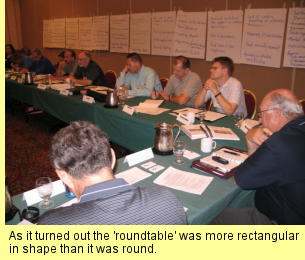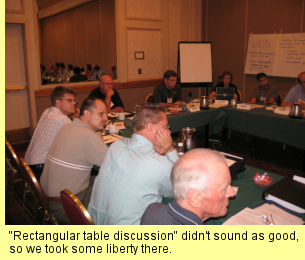|
Back to Webletter
Roundtable Represents Aviation Industry
By Donna Speidel
 The roundtable discussion was held to identify content for the Airfield Marking Best
Practices Handbook. The handbook is intended to describe practices that can improve the quality of airfield
markings. Participants from throughout the industry, including FAA staff, consulting engineers, airport marking
contractors, material manufacturers, airport managers and airport maintenance staff (military and commercial),
were invited to attend and offer their perspectives into the issues surrounding the much overlooked matter of
airfield markings. Each of the 30 participants was asked to identify one to three airfield marking issues/challenges
that should be included in the handbook. In doing so, each considered the following criteria:
The roundtable discussion was held to identify content for the Airfield Marking Best
Practices Handbook. The handbook is intended to describe practices that can improve the quality of airfield
markings. Participants from throughout the industry, including FAA staff, consulting engineers, airport marking
contractors, material manufacturers, airport managers and airport maintenance staff (military and commercial),
were invited to attend and offer their perspectives into the issues surrounding the much overlooked matter of
airfield markings. Each of the 30 participants was asked to identify one to three airfield marking issues/challenges
that should be included in the handbook. In doing so, each considered the following criteria:
- the extent to which the issue reflects a problem or challenge with respect to airfield markings,
- the extent to which there are best practices that indicate how this issue should be addressed,
- the potential improvement in the situation that can be achieved by addressing the issue/practice in the handbook.
During the meeting, we discussed the issues identified and developed a prioritized list of those that might be
included in the handbook given the resources available to the project team.
- Format of the Airfield Marking Best Practices Handbook
- Audience - Engineers, Airport Managers, Maintenance Managers, Airport Marking staff,
Marking Contractors, Inspectors, Military and Commercial interests.
- Literature Review - opportunity to comment on prevailing guidance literature currently in
existence.
- Content - purpose of the roundtable was to identify potential content for the handbook and
prioritize the issues that the handbook should address.
- Critical issues were defined and ranked in accordance with participants' votes. The prioritized rankings of
issues offered by the participants were distilled into the following list that will form the basis of the research project:
- Application Procedures to include equipment commonly used, how the equipment is calibrated to
insure correct material coverage, airport conditions (i.e., traffic, weather, etc.), types of pavement
surfaces, installation of both temporary and permanent markings, and the potential need to improve
clean up efforts.
- Surface Preparation to include a clear definition. The research team will attempt to develop ways
of determining when surface preparation is necessary, if not always, and what equipment is best suited
to do the work.
- Pavement Marking Removal will address what equipment should be used, how someone should
determine the type of removal to be done, how one would decide the degree of removal to be done,
and what constitutes pavement damage?
- Material selection is not always obvious. The research team will attempt to observe the different
marking materials already approved for use on airports, noting the advantages and disadvantages of
each. The pavement surfaces, existing markings, airport weather conditions, and airport operations
are all factors that will be studied to design a matrix for the engineer/airport consultant to assist in the
right material selection for the project.
- Project Design that includes airfield markings will address the standard specifications and guidance
literature, emphasizing the need to customize specifications to fit the project. Criteria will be developed
that will help those responsible identify when markings are effective, functional and performing well and
when they are not. We will also try to find tools for determining when maintenance is necessary. The
team will also discuss the need for enforcement of those specifications through measured and detailed
techniques for quality assurance.
 Not included in the Research Project, but a high-ranked priority for many of the participants,
is the need for certification training of inspectors, consulting engineers, airport personnel, and airport marking
contractors. Development of a training program falls outside of the scope of this research project, but might be
addressed at a later date.
Not included in the Research Project, but a high-ranked priority for many of the participants,
is the need for certification training of inspectors, consulting engineers, airport personnel, and airport marking
contractors. Development of a training program falls outside of the scope of this research project, but might be
addressed at a later date.
The Research Team, comprised of varied expertise within the industry, will travel to a
minimum twelve airports during the course of the project. Our mission is to observe the practices used within the
industry and comment, based on empirical evidence gathered at the airports, what works and what does not; i.e.,
what are poor, good, and best practices.
We extend our thanks to all who traveled to the roundtable discussion in June, for their
valuable contribution to this project, and for their dedication to improving airport markings for the industry.
Back to Webletter
|



 The roundtable discussion was held to identify content for the Airfield Marking Best
Practices Handbook. The handbook is intended to describe practices that can improve the quality of airfield
markings. Participants from throughout the industry, including FAA staff, consulting engineers, airport marking
contractors, material manufacturers, airport managers and airport maintenance staff (military and commercial),
were invited to attend and offer their perspectives into the issues surrounding the much overlooked matter of
airfield markings. Each of the 30 participants was asked to identify one to three airfield marking issues/challenges
that should be included in the handbook. In doing so, each considered the following criteria:
The roundtable discussion was held to identify content for the Airfield Marking Best
Practices Handbook. The handbook is intended to describe practices that can improve the quality of airfield
markings. Participants from throughout the industry, including FAA staff, consulting engineers, airport marking
contractors, material manufacturers, airport managers and airport maintenance staff (military and commercial),
were invited to attend and offer their perspectives into the issues surrounding the much overlooked matter of
airfield markings. Each of the 30 participants was asked to identify one to three airfield marking issues/challenges
that should be included in the handbook. In doing so, each considered the following criteria:
 Not included in the Research Project, but a high-ranked priority for many of the participants,
is the need for certification training of inspectors, consulting engineers, airport personnel, and airport marking
contractors. Development of a training program falls outside of the scope of this research project, but might be
addressed at a later date.
Not included in the Research Project, but a high-ranked priority for many of the participants,
is the need for certification training of inspectors, consulting engineers, airport personnel, and airport marking
contractors. Development of a training program falls outside of the scope of this research project, but might be
addressed at a later date.